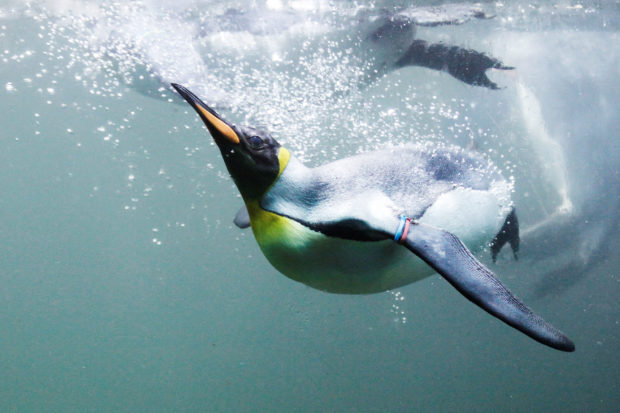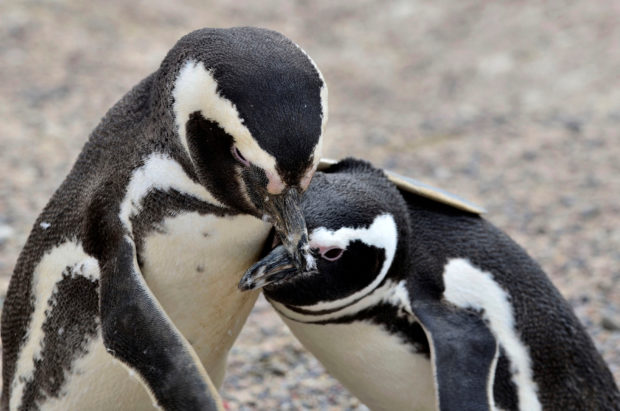Scientists uncover history of ‘ridiculously charming’ penguins

A king penguin swims in a pool at the zoo in Zurich August 15, 2012. REUTERS FILE PHOTO
WASHINGTON — The evolution of penguins from their flying seabird ancestors into the flightless denizens of marine environments from frigid Antarctica to the tropical Galapagos Islands is among the wonders of the animal kingdom.
Researchers on Tuesday offered the most thorough examination to date of the history of penguins dating back to their origins more than 60 million years ago, including identifying a suite of genes crucial in adaptations related to underwater vision, long dives, body temperature regulation, diet and body size.
The researchers sequenced the genomes of the 20 living penguin species and subspecies. With more than three quarters of known penguin species now extinct, the researchers also included in their analysis 50 fossil species using skeletal data.
The researchers said penguins evolved from a common ancestor shared with a group of seabirds that includes albatrosses and petrels. Penguins first evolved the ability to dive, like a puffin, and subsequently lost the ability to fly as they adapted to an aquatic realm, becoming excellent swimmers and divers.
The earliest-known penguin – dating back to 61 million years ago, about 5 million years after the mass extinction event that doomed the dinosaurs – is called Waimanu manneringi, from New Zealand.
“To me, penguins are a perfect example of a major evolutionary transition, like the evolution of an aquatic lifestyle in whales or flight in bats,” said avian paleontologist Daniel Ksepka of the Bruce Museum in Greenwich, Connecticut, co-author of the study published in the journal Nature Communications https://www.nature.com/articles/s41467-022-31508-9.
“We know penguins evolved from flying birds, but that happened over 60 million years ago and we need to look to the fossil record to piece together where, when and how that happened. Plus, penguins are ridiculously charming creatures. They love, they fight, they steal, and because of their funny upright posture it’s really easy to imagine them having all the same motivations as people,” Ksepka said.
The study illustrated how global temperature changes – oscillations between cold and warm periods – and shifts in major ocean currents have been important drivers of penguin evolution.
“We estimated how populations of each penguin species fluctuated over the last 250,000 years from signatures left in their genome by population crashes and booms,” Ksepka said. “The waxing and waning of ice sheets had a big impact on penguins, and species vulnerable to receding sea ice may suffer greatly from future global heating.”
Penguins also were found to exhibit the lowest evolutionary rates yet detected among birds.

Magellanic penguins interact at the Punta Tombo fauna reservation in the southern Argentinian province of Chubut November 24, 2011. REUTERS FILE PHOTO
Penguins live primarily in the Southern Hemisphere, including species like the Adelie penguin along Antarctica’s coastlines. The Galapagos penguin is the only one found north of the equator.
University of Copenhagen postdoctoral researcher and study lead author Theresa Cole said the research uncovered a variety of genes likely involved in unique penguin physiological adaptations.
They show gene mutations that shift their vision toward the blue end of the color spectrum. Blue light penetrates more deeply into the ocean than light at the red end of the spectrum, so this trait helped fine-tune vision for low-light, underwater acuity.
Genes that help birds detect salty and sour tastes are active in penguins. But genes that help detect bitter, sweet and savory tastes are inactivated. Those may no longer be needed as penguins forage in cold, salty water and typically swallow prey including fish, shrimp and squid whole.
Penguins exhibit a flattening and stiffening of their wing bones and a reduction of their flight feathers into tiny structures that help convert wings into flippers. They also reduced the air spaces in the skeleton and increased bone wall thickness to increase diving efficiency, as well as adding the ability to store more oxygen in their muscles for long dives.
Penguins were once much larger than today’s species. One species, Kumimanu biceae, that inhabited New Zealand between 55 and 60 million years ago stood about 6 feet (1.8 meters) tall. The largest extant species, the emperor penguin, is about 3 feet (1 meter) tall.
RELATED STORIES
Penguins get picky, piqued by penny-pinching zoo
Penguins offer varied clues to Antarctic climate change
These penguins comforting each other is the cutest thing on the internet today
Yellow penguin snapped by wildlife photographer: ‘How lucky could I be!’